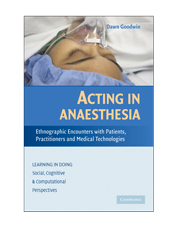Book contents
- Frontmatter
- Contents
- Series Foreword
- Acknowledgements
- Acting in Anaesthesia: Ethnographic Encounters with Patients, Practitioners and Medical Technologies
- 1 Understanding Anaesthesia: Theory and Practice
- 2 Refashioning Bodies, Reshaping Agency
- 3 Accounting for Incoherent Bodies
- 4 Teamwork, Participation and Boundaries
- 5 Embodied Knowledge: Coordinating Spaces, Bodies and Tools
- 6 Recognising Agency, Legitimating Participation and Acting Accountably in Anaesthesia
- References
- Index
- Titles in the series
6 - Recognising Agency, Legitimating Participation and Acting Accountably in Anaesthesia
Published online by Cambridge University Press: 20 August 2009
- Frontmatter
- Contents
- Series Foreword
- Acknowledgements
- Acting in Anaesthesia: Ethnographic Encounters with Patients, Practitioners and Medical Technologies
- 1 Understanding Anaesthesia: Theory and Practice
- 2 Refashioning Bodies, Reshaping Agency
- 3 Accounting for Incoherent Bodies
- 4 Teamwork, Participation and Boundaries
- 5 Embodied Knowledge: Coordinating Spaces, Bodies and Tools
- 6 Recognising Agency, Legitimating Participation and Acting Accountably in Anaesthesia
- References
- Index
- Titles in the series
Summary
I began this study with questions about learning knowing and doing: who/what can act, in what ways, how is this learnt and how are actions recognised and rendered accountable. My concern relates to what is made visible and what is left unacknowledged in the drive to shape the organisation and delivery of health care around standardised practices and the implications of this. The ways in which this standardising ambition is manifested are manifold – EBM, patient safety initiatives, clinical governance and professional accountability, to name but a few. I have focussed my analysis on EBM and professional accountability in particular, but I believe the strength of all these approaches lies in their coherence around a human-centred, individual model of action in which decision making is a discrete cognitive process that can be isolated and located to certain individuals at certain points in time and place.
A quite different view of health care practice is advanced in this book: one in which clinicians and patients act in concert with each other and various medical technologies, machines and devices. Activity, decisions and participation are fluid, and agency is relational. In supporting a collaborative notion of practice, and a socially, materially, temporally and spatially distributed view of action and decision making, I have sought to counter the conception of the patient's wishes and contributions, the sociotechnical and material environment and other situational contingencies, as somehow being ‘obstacles’ to implementing a pre-defined plan of care.
- Type
- Chapter
- Information
- Acting in AnaesthesiaEthnographic Encounters with Patients, Practitioners and Medical Technologies, pp. 167 - 176Publisher: Cambridge University PressPrint publication year: 2009



